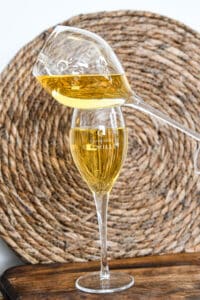
COMPOSITION OF CHAMPAGNE – OENOLOGICAL PARTICULARITIES
When discussing the composition of Champagne, one inevitably thinks of the three grape varieties that account for 99% of production: Pinot Noir, Meunier, and Chardonnay.
You have never been able to taste a red Champagne. And for good reason: in 1936, the winemakers, organized into a union federation since 1904, obtained the Appellation d’Origine Contrôlée (AOC) Champagne to protect their expertise and preserve the Champagne myth intact…
SUMMARY

In a previous article, we discussed the different grape varieties of Champagne, of which there are seven types authorized in Champagne: Pinot Noir, Meunier, Chardonnay, Arbane, Petit Meslier, Pinot Blanc, and Pinot Gris. 85% of the 50 hectares of vines at Maison Gremillet are composed of Pinot Noir, a grape that represents nearly 40% of the vineyards in Champagne, ahead of Meunier (31%) and Chardonnay (30%). Therefore, the majority of the grapes are dark-skinned, leading to the question about the color of Champagne: « Why isn’t Champagne red? » The maceration of dark grapes would easily allow for this. This is, in fact, how another Champagne appellation, a true gem, the Côteaux Champenois, is produced—a still wine made from Champagne grapes, which can be red, white, or rosé.
Did you know, first of all, that Champagne is something of a miracle? The Appellation d’Origine Contrôlée (AOC) came about in a very particular context. Between the end of the 19th century and the beginning of the 20th century, an aphid wreaked havoc on French vineyards. Indeed, phylloxera, introduced accidentally with American vine roots, forced winegrowers to uproot their vines. Over 2 million hectares across the French territory were affected… This was followed by years of rebuilding and difficulties for all wine professionals. Champagne producers sought first to protect their treasure from the many wrongdoers wanting to exploit the prestige of « Champagne. » The first step before the Appellation d’Origine Contrôlée came in 1927, with the delimitation of the Champagne wine region and the establishment of the first quality and color criteria! Only white and rosé were selected. Our collection pays homage to them. Whether classic or unique, our creations come in both colors!

The Champagne Gremillet estate is located in the Côte des Bar, near Les Riceys. Every day of the year, we cherish our beloved grape variety, Pinot Noir, a red or dark-skinned grape that thrives perfectly on our clay-limestone soils. This historic and ancestral grape variety originates from our neighboring Burgundy, bringing vitality and a full palette of aromas, notably red and black fruits, to our cuvées. The second grape variety used in our collection is Chardonnay, synonymous with freshness, finesse, and elegance! Depending on the cuvées, we either work with a single grape variety or let the magic of blending take place. Except for the production of Rosé, in Champagne, we always seek to obtain a white juice. To achieve this, the freshly harvested grapes must be quickly pressed to prevent the start of the maceration process, during which contact with the dark skins would tint the juice.
For each of our Champagnes, a technical sheet on our online store precisely details the composition of our blends (the percentage of Pinot Noir and Chardonnay). For example, the Brut Sélection is composed of 70% Pinot Noir and 30% Chardonnay. Jean-Christophe Gremillet, our cellar master, also shares some insights on each of our Champagnes, including when and with what to serve them.
While Champagne does not permit the red color, there are indeed sparkling red wines. The process is similar to that of a maceration Rosé, except that the maceration is longer to achieve more intensity and color. And if you want to combine the color and bubbles of Champagne, our maceration rosé, which we call Rosé Vrai, should captivate you.**

When discussing the composition of Champagne, one inevitably thinks of the three grape varieties that account for 99% of production: Pinot Noir, Meunier, and Chardonnay.

For many decades, the production of Champagne has followed a precise and well-established process. The making of Champagne respects traditions and practices, which Maison Gremillet

Understanding the Difference Between Non-Vintage Brut Champagne and Vintage Champagne. The world of Champagne is vast and varied, offering a multitude of choices for wine